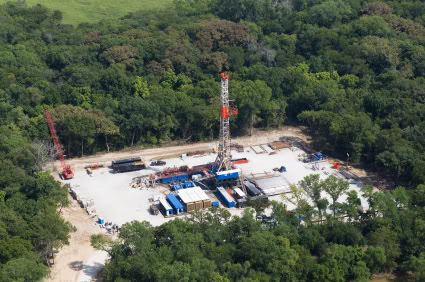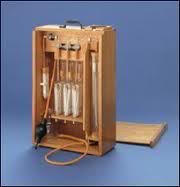ALL4’s: Is That Your Final Answer?
Last Month’s Answer and Winner:
Proving that you have to be quick to win at “Is That Your Final Answer,” Bridgette Rillema identified ice cream as the correct answer to May’s question concerning the pulp and paper industry and a cool summer-time treat. Just minutes after Bridgette’s e-mail arrived, correct answers from Scotty, Steve, Brian (who provided a very complete answer), and Hobie also popped up, which only underscores just how important a quick internet connection can be.
Question:
June’s “Is That Your Final Answer” question consists of a visual clue. Eric Swisher, ALL4’s resident continuous emission monitoring (CEM) and stack testing expert was discussing the pros and cons of manual and continuous emission testing methods with a group of engineers at ALL4. When he showed them the picture to the right, no one could believe that Eric was old enough to have actually used one of these. What is the emission testing equipment in the picture called?
Answer:
Please e-mail your answer to final.answer@all4inc.com. Include in the e-mail your name, answer, and address (to receive your prize).
PM2.5: Repeal and Reminder
U.S. EPA has repealed the Prevention of Significant Deterioration (PSD) “Grandfathering” provision for particulate matter with an aerodynamic diameter of less than 2.5 microns (PM2.5). Facilities that submitted PSD construction permit applications prior to the promulgation of the PM2.5 New Source Review (NSR) regulations could demonstrate compliance with PM2.5 permitting requirements by addressing PM10 only, even if the final permit had not been issued after promulgation of the PM2.5 regulations. The relatively few applications that addressed PM10 only and that were still pending from a pre-PM2.5
Marcellus Shale in New York – The Saga Continues
While numerous drilling operations in Pennsylvania and West Virginia have begun to tap the vast natural gas resources in the Marcellus Shale formation during the past several years, New York has been, to put it mildly, reluctant to join the party. Drilling operations in the State have been on hold thanks to a December 11, 2010 executive order issued by then-Governor David Paterson. The executive order established a moratorium on new horizontal, high-volume, hydraulic fracturing (“hydrofracking”) until July 1, 2011 in order to allow sufficient time for the New York State Department of Environmental Conservation (NYSDEC) to complete an Environmental Impact Statement (EIS) that outlines the processes and procedures to be implemented as permit conditions for drilling in the Marcellus Shale with the use of hydrofracking. As the expiration date of the moratorium approaches, legislative activity has picked up once again.

Please contact ALL4’s Glenn Watson at 610.933.5246 x35 (gwatson@all4inc.com) with any questions regarding the decision to extend the moratorium in New York.
Compliance Alert
ALL4 has observed a concerted increase in U.S. EPA compliance inspection activity at major source facilities in recent months. These inspections are not like your typical state compliance inspection and do not appear to be focused on a specific industry or industrial sector. Most often U.S. EPA is primarily looking to review documents, with the in-plant “walk-around” inspection as a secondary concern. U.S. EPA is looking for past plant improvement projects (capital or otherwise) that could have triggered major New Source Review (NSR) permitting for major sources, but were not ultimately permitted under the applicable NSR program.
Companies are not given much advance notice for these inspections, typically on the order of a week. One of the other things U.S. EPA is checking for is whether the facility has been keeping all of the records required by the facility operating permit. The most important thing that you can do to prepare for these inspections is to be certain that you have all of your records organized; and all of your construction permits and their 
If you are targeted for an inspection, you will not have much time to prepare. Therefore, take these inspections very seriously; anytime U.S. EPA comes to your facility, it is a big deal. To learn more about how to prepare for a facility inspection, take a look at this article from an earlier edition of 4 The Record.
ALL4 Attends U.S. EPA Regional, State, and Local Dispersion Modelers Workshop
ALL4’s ambient group members Dan Dix and Colin McCall attended the U.S EPA Regional, State, and Local Dispersion Modelers Workshop (Workshop) held in Atlanta, GA on June 9, 2011. The annual meeting, which is hosted by the U.S. EPA Office of Air Quality Planning and Standards (OAQPS) and attended by state and local modelers to communicate various technical issues and solutions related to local-scale air quality modeling, was open to the public on the last day of the week-long meeting for the first time in recent memory. The focus of the meeting was the newly established 1-hour nitrogen dioxide (NO2) and sulfur dioxide (SO2) National Ambient Air Quality Standards (NAAQS), and less new 24-hour particulate matter less than 2.5 microns (PM2.5) NAAQS.
Boiler MACT…Yes…No…Maybe?
Background
On March 21, 2011, U.S. EPA published a final rule regulating hazardous air pollutant (HAP) emissions from boilers and process heaters located at major sources of HAP emissions (Boiler MACT). On that same date, U.S. EPA also published a notice that it was going to initiate a reconsideration process for several portions of the rule because U.S. EPA believed that the public should have the opportunity to comment on some of the last-minute changes that were made to the rule in order to meet the court-ordered deadline for finalizing the rule, including changes that were made to the boiler categories and boiler emission limitations.
Because U.S. EPA has an abundance of comments to evaluate, several industry groups have filed petitions for judicial review of the rule and litigation against U.S. EPA is pending. U.S. EPA published notice in the Federal Register on May 18, 2011 that it was delaying the effective date for the final Boiler MACT until such a time as the proceedings for judicial review are completed or until U.S. EPA completes its reconsideration of the rule, whichever is earlier. Without an effective date, the Boiler MACT will remain unenforceable until such time as it becomes effective. In other words, by delaying the effective date of the Boiler MACT, U.S. EPA essentially figured out a clever way to meet the court-ordered deadline for finalizing a Boiler MACT rule and then quickly take the rule off the books to allow the agency additional time to consider the public’s comments. Without an effective date, it is as if the Boiler MACT does not exist.
Limits Properly Set or Flawed Logic?
Many questions surround the logic that U.S. EPA used to develop the emission limits contained in the Boiler MACT. One potential flaw identified by those petitioning U.S. EPA for judicial review of the Boiler MACT is the establishment of emissions limitations using data collected from boilers that fire fuels that would now be classified as non-hazardous secondary materials (NHSM). In other words, based on U.S. EPA’s new definition of a solid waste (also published in the Federal Register on March 21, 2011), some boilers should be classified as Commercial and Industrial Solid Waste Incinerator (CISWI) units. Combustion units that have historically fired fuels such as tire derived fuel (TDF), wastewater treatment plant (WWTP) residuals, used oil, and resinated wood (e.g., plywood, oriented strand board, etc.) could potentially be subject to the New Source Performance Standards or Emissions Guidelines for CISWI units published in 40 CFR Part 60, Subparts CCCC and DDDD, respectively. Some commenters believe that the data collected from these boilers should not have been used to establish emission limits under the Boiler MACT, and instead should have been used to establish emission limits for CISWI units. It’s worth noting that the effective dates of the amended CISWI Rules were also delayed in the May 18, 2011 Federal Register notice. However, the effective date of the definition of solid waste rule (DSW Rule) was not.
By using U.S. EPA’s new DSW Rule to question the data that U.S. EPA used to develop emission limits for the Boiler MACT, commenters are able to draw some much needed attention to some of the seemingly absurd assumptions that U.S. EPA made when developing the DSW Rule. For example, a boiler firing TDF made from tires that are removed from vehicles and managed under an approved collection program would be subject to the Boiler MACT because, under that scenario, U.S. EPA determined that TDF made from such tires is not discarded and therefore not considered a waste. However, a boiler firing TDF that contains tires reclaimed from a pile or defective tires that were never used on a vehicle would be classified as an incinerator and subject to the CISWI Rules because only those tires that are removed from vehicles and managed under an approved collection program are not considered discard and therefore not considered to be a waste. TDF purchased from one fuel supplier could therefore be a solid waste while TDF purchased from another fuel supplier might not be a solid waste. Because the DSW Rule did not exist when U.S. EPA was evaluating emissions data to establish new emission limits under the Boiler MACT and CISWI rules, how did U.S. EPA determine whether a combustion unit was a “boiler” or a CISWI unit? How could U.S. EPA have determined whether the emissions data collected were representative of a boiler or a CISWI unit without evaluating each fuel stream based on the new DSW Rule? Did U.S. EPA develop new emission limits for boilers using data collected from CISWI units? If so, the data should have been used to establish emission limits under the CISWI Rules.
How Long Will the Effective Date Be Delayed?
U.S. EPA cannot predict how long the reconsideration process will last, but one U.S. EPA employee has told ALL4 off-the-record that he believes the reconsideration process could last a year or more. Although the effective dates of the new Boiler MACT and CISWI Rules have been postponed, do not automatically assume that the compliance dates associated with each rule will be changed as part of the reconsideration process. Unless the changes to these rules are significant, U.S. EPA may not see the need to postpone the compliance dates. So, should you sit around and wait to see what happens with the Boiler MACT before taking any action? You certainly could, but we don’t recommend it. Here’s a brief list of some of the things you can be doing right now to prepare yourself for the final (or is it final final?) publication of the Boiler MACT:
- Review the DSW Rule and determine whether any of the fuels that you currently burn are considered to be solid waste. U.S. EPA clearly stated in the Federal Register that the DSW Rule was no longer open for comment and would not be reconsidered. If you determine that you are burning a NHSM that is a solid waste, your combustion unit will be subject to the CISWI Rules unless you permanently cease firing the waste six months before the compliance date.
- Evaluate the emissions from your combustion unit. Conduct emissions testing, if needed, while firing your worst-case fuel (or fuels) for comparison to the emission limits in the Boiler MACT and/or CISWI Rules. Although U.S. EPA may change some of the numerical emission limits during the reconsideration process, the pollutants regulated by the rules are not likely to change. You should be actively gathering as much information as possible about your combustion units so that you can hit the ground running once the reconsideration process is completed. Remember, U.S. EPA estimates that there are over 13,000 existing boilers that will be subject to the Boiler MACT once it becomes effective, and every facility will be rushing to comply with this rule at the same time. Outside resources could quickly become limited.
- Begin developing relationships with control device vendors and/or boiler optimization companies. Develop an understanding of the technologies and techniques available to reduce emissions of the pollutants regulated by the Boiler MACT. Develop an understanding of the capital costs, operating costs, and limitations associated with each emission reduction technology and technique.
- Evaluate the cost and availability of alternative fuels. Switching fuels may subject your combustion unit to emission limitations that can more easily and cost effectively be achieved.
- Be creative and evaluate other options potentially available to your facility. Can you make process improvements to reduce steam demand enough to decommission one of your boilers? Given the choice, most of the companies that ALL4 works with would rather spend their money on making process improvements than spend it on environmental control systems for older boilers.
- Perform your required energy audit now.
Slade’s Corner – Avoiding Regulatory “Fatigue”
It seems like there is a new air quality regulatory initiative being launched by U.S. EPA every week or so. From New Source Review (NSR) interpretations to greenhouse gas (GHG) programs to Maximum Achievable Control Technology (MACT), the litany of new and more stringent requirements never seems to end. Your state and local air pollution control agencies are also extra busy these days. It is very important that you, as an environmental manager, avoid regulatory fatigue and remain diligent in your regulatory reconnaissance efforts on all fronts (Federal, state, and, as applicable, local).
With all of the new National Ambient Air Quality Standards (NAAQS) for ozone, PM2.5, SO2, and NOX, State and Local regulatory agencies must revise their State Implementation Plans (SIPs) to provide for both reductions in areas of nonattainment and for maintenance to stay in compliance for areas already in attainment. Agencies must look at all reasonably available control measures (RACM), which, along with things like transportation control measures, also include new rounds of Reasonably Available Control Technology (RACT) for stationary sources. Most companies that are major sources (at least in Pennsylvania) have a very strong remembrance of the work effort involved with past requirements for RACT controls on emissions of NOX and VOC for ozone nonattainment. Over the next few years (some as soon as the next year), agencies will be going through a similar process of determining what RACT controls will be required for sources located in or significantly impacting all areas of NAAQS nonattainment.

Slade’s Corner is a regular column appearing in ALL4’s 4 The Record. John Slade is a Sr. Consultant with ALL4 and spent many years as a regulator with the Pennsylvania Department of Environmental Protection (PADEP), including nearly 14 years as Chief of the Division of Air Quality Permitting. Want to reach John or suggest an upcoming topic for Slade’s Corner? Contact John at jslade@all4inc.com or 717.822.0009. Slade’s Corner is an opinion-based column, and its content does not necessarily represent the opinion of ALL4 as a whole.
Note from the author: This article is based on my candid opinions as of the date it was written and I reserve the right to change my mind as information evolves!


